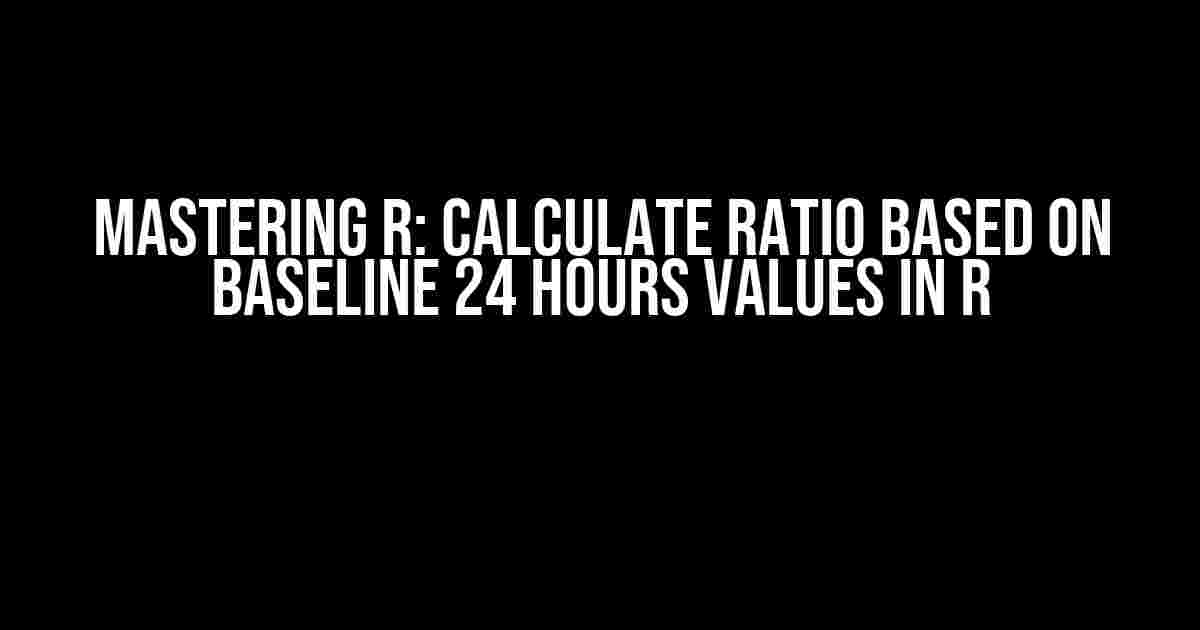Are you tired of manually crunching numbers to calculate ratios based on baseline 24 hours values in R? Do you wish there was a way to simplify this process and get accurate results quickly? Look no further! In this article, we’ll take you on a step-by-step journey to master the art of calculating ratios based on baseline 24 hours values in R.
What are Baseline 24 Hours Values?
In data analysis, baseline 24 hours values refer to a set of data points collected over a 24-hour period, usually serving as a reference point for further calculations. These values can be anything from temperature readings, stock prices, website traffic, or even medical data. The goal is to calculate a ratio based on these values to gain insights into patterns, trends, or correlations.
Why Calculate Ratios?
Calculating ratios based on baseline 24 hours values helps you:
- Identify trends and patterns in the data
- Compare values across different time periods or groups
- Determine correlations between variables
- Make informed decisions based on data-driven insights
Preparing Your Data in R
Before we dive into calculating ratios, let’s assume you have a dataset in R with the following structure:
# Create a sample dataset
data <- data.frame(
Time = c(1:24),
Value = c(10, 12, 15, 18, 20, 22, 25, 28, 30, 32, 35, 38, 40, 42, 45, 48, 50, 52, 55, 58, 60, 62, 65, 68)
)
# View the dataset
data
| Time | Value |
|---|---|
| 1 | 10 |
| 2 | 12 |
| 3 | 15 |
| 24 | 68 |
Calculating Ratios in R
Now that we have our dataset, let's calculate the ratio of each value to the baseline 24 hours value.
Method 1: Using the `/` Operator
We can use the `/` operator to divide each value by the baseline value. In this case, we'll use the last value (index 24) as the baseline.
# Calculate ratio using the `/` operator
data$Ratio <- data$Value / data$Value[24]
# View the result
data
| Time | Value | Ratio |
|---|---|---|
| 1 | 10 | 0.147059 |
| 2 | 12 | 0.176471 |
| 3 | 15 | 0.220588 |
| 24 | 68 | 1.000000 |
Method 2: Using the `scale()` Function
We can also use the `scale()` function to standardize the values and calculate the ratio.
# Calculate ratio using the scale() function
data$Ratio <- scale(data$Value, center = data$Value[24], scale = data$Value[24])
# View the result
data
| Time | Value | Ratio |
|---|---|---|
| 1 | 10 | -0.852941 |
| 2 | 12 | -0.794118 |
| 3 | 15 | -0.735294 |
| 24 | 68 | 0.000000 |
Interpreting the Results
Now that we have calculated the ratios, let's interpret the results:
- A ratio of 1 indicates the value is equal to the baseline value.
- A ratio less than 1 indicates the value is lower than the baseline value.
- A ratio greater than 1 indicates the value is higher than the baseline value.
Visualizing the Ratios
To gain a better understanding of the ratios, let's visualize the data using a line chart.
# Load the ggplot2 library
library(ggplot2)
# Create a line chart
ggplot(data, aes(x = Time, y = Ratio)) +
geom_line() +
labs(x = "Time", y = "Ratio") +
theme_classic()
The resulting chart will show the ratios over time, providing a clear visual representation of the data.
Conclusion
Calculating ratios based on baseline 24 hours values in R is a straightforward process. By using the `/` operator or the `scale()` function, you can easily calculate ratios and gain insights into your data. Remember to interpret the results correctly and visualize the data to uncover patterns and trends.
With this newfound knowledge, you'll be able to tackle complex data analysis tasks and make data-driven decisions with confidence. Happy coding!
Frequently Asked Question
Get ready to boost your R skills with these frequently asked questions about calculating ratios based on baseline 24 hours values in R!
How do I calculate a ratio based on a baseline 24 hours value in R?
To calculate a ratio based on a baseline 24 hours value in R, you can use the following formula: `ratio = (new_value / baseline_value) * 100`. This formula will give you a percentage change from the baseline value. For example, if your baseline value is 100 and your new value is 120, the ratio would be `(120 / 100) * 100 = 120%`, indicating a 20% increase from the baseline.
How do I calculate a ratio for multiple observations in R?
To calculate a ratio for multiple observations in R, you can use the `mutate` function from the `dplyr` package. For example, if you have a dataframe `df` with columns `baseline` and `new_value`, you can calculate the ratio as follows: `df %>% mutate(ratio = (new_value / baseline) * 100)`. This will add a new column `ratio` to your dataframe with the calculated ratios.
Can I use a different baseline value for each observation in R?
Yes, you can use a different baseline value for each observation in R. One way to do this is to create a new column with the baseline values and then use it to calculate the ratio. For example, if you have a dataframe `df` with columns `id`, `baseline`, and `new_value`, you can calculate the ratio as follows: `df %>% group_by(id) %>% mutate(ratio = (new_value / baseline) * 100)`. This will calculate the ratio for each group of observations defined by the `id` column.
How do I handle missing values when calculating ratios in R?
When calculating ratios in R, you can handle missing values using the `ifelse` function or the `coalesce` function from the `dplyr` package. For example, you can use `ifelse` to replace missing values with a specific value, such as 0, as follows: `df %>% mutate(ratio = ifelse(is.na(baseline), 0, (new_value / baseline) * 100))`. Alternatively, you can use `coalesce` to replace missing values with a specific value, such as the mean of the non-missing values.
Can I visualize the calculated ratios in R?
Yes, you can visualize the calculated ratios in R using various visualization packages, such as `ggplot2` or `plotly`. For example, you can create a bar chart using `ggplot2` as follows: `ggplot(df, aes(x = id, y = ratio)) + geom_bar()`. This will create a bar chart showing the ratio values for each observation. You can customize the chart as needed to better visualize your data.






